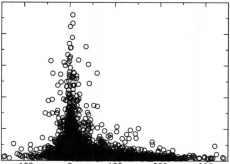Abstract
We have performed molecular dynamics simulations of glassy trehalose with various amounts of glycerol in order to explore the tendency for glycerol to antiplasticize the glass. We find that below a temperature of 300K, the average density of the system containing 5%wt glycerol is larger than that of the pure trehalose system; the glass transition temperature is decreased, and the elastic constants are essentially unchanged. Taken together, these phenomena are indicative of mild antiplasticization, a type of behavior generally observed in polymeric systems. We have calculated the local elastic constants in our glassy materials and, consistent with previous simulations on a coarse-grained polymer, we find evidence of domains having negative elastic moduli. We have explored the ability of various measures of the Debye–Waller factor ⟨u2⟩ to predict the stiffness of our systems in terms of their elastic constants. We find that ⟨u2⟩ is indeed correlated with the behavior of the bulk elastic constants. On a local level, a correlation exists between the local moduli and ⟨u2⟩; however, that correlation is not strong enough to arrive at conclusive statements about the local elastic properties.
